Which new tower cranes offer advanced safety tech?
19 February 2024
The latest tower crane technology enhances safety on site and improves lifting capabilities on different projects. Niamh Marriott reports.
Manufacturers are meeting market needs by recognising what operational benefits a new tower crane might need and identifying what safety features are most in demand. There’s also a question of location and spotting what features are required for different regions and why.
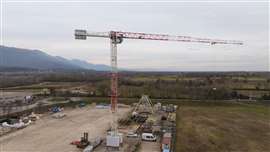 Terex to launch its updated CTT 152-6 flat top tower crane. (Photo: Terex)
Terex to launch its updated CTT 152-6 flat top tower crane. (Photo: Terex)
ICST can report that construction equipment manufacturer Terex will soon launch a new version of a city class flat top tower crane to the market. The CTT 152-6 is a 6 tonne lifting capacity crane with a maximum jib length of 60 metres and a tip load up to 1.91 tonnes. It features an easy set up and is provided with S-Pace cabin and the latest Terex technologies such as Power Match and T-Torque slewing, which the company says will improve efficiency in daily lifting operations.
The new model will have two winch options (18 or 22 kW) to satisfy the different needs of the market and there are new design improvements such as a pinned connection between the jib and slewing unit, and the removal of counter jib ballast to simplify and speed up installation.
Manufacturer Manitowoc’s Potain division has announced a new luffing jib tower crane designed to increase the efficiency of construction projects.
Its optimised design means the new MCR 305 offers benefits such as fewer building ties when climbing, and a shorter out of service radius than on previous models.
 Potain’s new MCR 305 luffing jib tower crane. (Photo: Manitowoc)
Potain’s new MCR 305 luffing jib tower crane. (Photo: Manitowoc)
Two versions are available, both with a 60 metre maximum jib. The MCR 305 H25 offers a capacity of 25 tonnes with a tip load of 3 tonnes. MCR 305 H20 lifts 20 tonnes and offers a tip load of 3.1 tonnes.
To reach a height of 194.3 metres the new model needs six tower ties to the building. The existing MCR 295 needs 11 ties to reach 192.6 metres. In addition to saving money, fewer ties help reduce the time pressure on the tight schedules of today’s projects.
With a full 60 metre jib the out of service radius on the MCR 305 is 12.5 metres, not far off half the 22 metres of the MCR 295, also with a 60 metre jib. This could be enough to mean the difference between being able to get two cranes on a cramped site instead of just one, the manufacturer says.
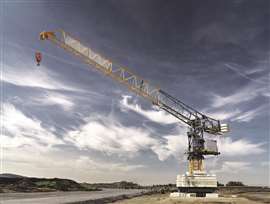 A prototype of Liebherr’s 195 HC-LH 6/12 was shown at Bauma 2022 and first models should start shipping early in 2024. (Photo: Liebherr)
A prototype of Liebherr’s 195 HC-LH 6/12 was shown at Bauma 2022 and first models should start shipping early in 2024. (Photo: Liebherr)
Manufacturer Liebherr has confirmed that its 195 HC-LH 6/12 crane, first shown at the Bauma exhibition in 2022, will soon be ready to ship to customers. The hydraulic luffing jib crane has a small footprint and can be easily transported to the jobsite. Liebherr says the crane was specifically designed to be easy to erect.
Italian manufacturer FM Gru also showcased its FM 2065 TLX flat top tower crane at Bauma 2022. Since then the crane has been erected on a project in Beernem, Belgium, where it is being used for the construction of apartments. It will be on site for one year.
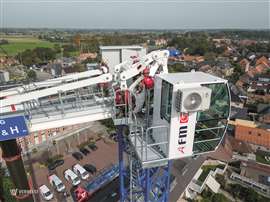 FM Gru’s tower crane has platforms under the hoisting and trolley motors to increase safety. (Photo: FM Gru)
FM Gru’s tower crane has platforms under the hoisting and trolley motors to increase safety. (Photo: FM Gru)
Tip load capacity
FM Gru’s crane, which has a maximum 65 metre jib, boasts the Ultra Lift system which the company says allows for a 10 per cent increase in tip load capacity.
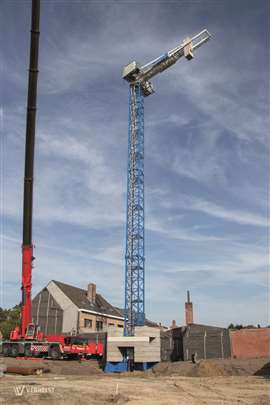 FM Gru first showcased its FM 2065 TLX tower crane at Bauma 2022. (Photo: FM Gru)
FM Gru first showcased its FM 2065 TLX tower crane at Bauma 2022. (Photo: FM Gru)
FM Gru’s crane also has a black box system, a module for recording and transmitting data via USB, through two interface displays (one 7 inch in the cab and one 3.5 inch in the electrical panel). The module has an integrated zoning and collision avoidance system, and a special load position memory system.
The crane’s cabin has plenty of comfort and safety features for operators, including a touchscreen display, and has platforms under the hoisting and trolley motors to increase safety.
Seeing double
Elsewhere in Italy, manufacturer ENG Cranes has two cranes which it says are currently unique to the tower crane industry, its EDL series with patented double counter jib and its ETH series, which is a hydraulic luffer that has no counter jib.
ENG Cranes’ EDL series can work both as a traditional crane and as a luffer, the company says. “In flat mode, it operates as a typical tower crane. However, what makes it exceptional is its ability to switch to luffer mode simply by the crane operator in the cabin,” says a spokesperson for the company.
“This crane is innovative in every aspect of its design, including the double counterweight solution, which ensures greater stability and versatility.”
The two counterweights are designed to work in tandem, ensuring that the crane remains stable even when facing challenging weather conditions such as strong winds. This increased stability minimises the risk of accidents and enhances safety for both operators and the surrounding environment, ENG says.
ENG adds, “The range is getting bigger this year as we have been working on the EDL 230 which features 16 tonnes of maximum lifting capacity and 60 metres of jib, the biggest crane of this new range of tower cranes as of right now.”
Space saving
ENG Cranes’ ETH crane series lifts of 30 tonnes and offers a maximum radius of 56 metres. ENG says what sets its ETH crane series apart is its innovative design and improved functionality.
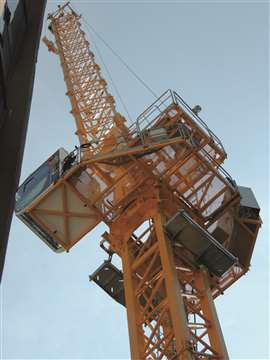 ENG says what sets its ETH crane series apart is its compact design. (Photo: ENG Cranes)
ENG says what sets its ETH crane series apart is its compact design. (Photo: ENG Cranes)
“Unlike traditional luffers, our hydraulic luffer boasts a sleek and space-saving design. It takes up minimal room on your construction site, allowing for more efficient operations even in tight spaces,” adds ENG.
“Precision is key in any construction project, and our hydraulic luffer delivers just that. With advanced hydraulic systems and controls, you can position heavy loads with pinpoint accuracy, reducing the risk of accidents and improving overall project efficiency.
“After the experience with the initial models designed and produced as a powerful derrick used for disassembling tall internal climbing cranes, it led us to develop a hydraulic luffer version based on the same crane to be used on tight construction sites. This feature allows its use where traditional luffers occupy too much space.
“In late 2023, we expanded this range of models, which now includes four versions, ranging from 8 to 16 tonnes of maximum load.”
Models from both series are working in North America, Asia and the UK.
Global access
There is increasingly greater global access for tower cranes.
German tower crane specialist BKL recently added two new locations for its cranes in Nuremberg and Ansbach, Germany. Following a recent acquisition of construction company Knoll, BKL crane solutions are now available at nine locations and it sells its cranes both in Europe and worldwide.
Thibaut Le Besnerais, Manitowoc Potain vice president for brand and product management, tower cranes, says, “Despite an uncertain economic climate in the European construction industry, the current market is paying particular attention to high capacity machines, especially for heavy infrastructure work.
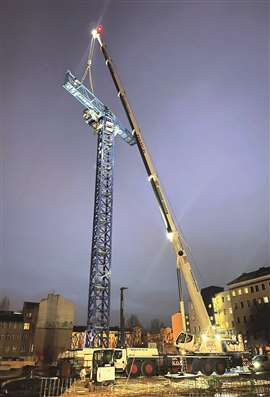 BKL now offers tower crane solutions from nine locations. (Photo: BKL)
BKL now offers tower crane solutions from nine locations. (Photo: BKL)
“A case in point is the Cavagna viaduct renovation project in Italy, where four MDLT 1109 have been erected (maximum load of 40 tonnes). Launched in 2023, this machine benefits from a new concept that offers high lifting performance while being easy to transport and assemble.
“This demand for high-capacity machines is also present and growing in other parts of the world. The Potain MCT 1005 and MCT 1105 topless cranes, manufactured in the Zhangjiagang factory, in China, have also enjoyed great success since the launch in March 2023.”
New tech
At the Bauma 2022 tradeshow, manufacturer Wolffkran showed its High Speed Positioning System (HiSPS) of electronic assistance which enables loads on the crane hook to be moved virtually sway-free and precisely positioned. Now, the patent-pending technology is available for order together with Wolffkran’s latest offering, the Wolff 6523 Clear crane.
From the beginning of 2024 Wolff models will carry the option of activating the HiSPS. Existing Wolff cranes can also be retrofitted.
The connectable HiSPS assistance system operates using two battery-powered sensors on the trolley and the hook block. Connected to a control unit in the switch cabinet, it detects the rope’s movements and automatically adjusts the motion and speed of the slewing gear and trolley to it.
“Ultimately, the crane operator controls more than the crane – they control the load with assistance from the system,” explains Viktor Mosolf, head of the digitalisation department at Wolffkran.
HiSPS can be used to eliminate heavy wind effects too, Wolffkran says.
Tower crane manufacturers continue to answer the industry demands with new offerings and clever technology solutions that improve safety on sites around the world.
Roll up for the TCNA tower crane conference
KHL Group invites companies and individuals to attend the 2024 Tower Cranes North America (TCNA) conference, which will be held in Nashville, Tennessee, USA, on 11 and 12 June 2024.
Organised by KHL Group, American Cranes & Transport and International Cranes and Specialized Transport magazine, the conference will focus on the North American tower crane market, looking at trends in technology, fleet management, major projects and the business of tower cranes.
For more information go to: www.khl-tcna.com
Liebherr works inside Cathedral
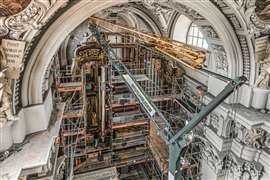 The world’s largest Catholic church organ is being renovated with the help of a Liebherr L1-24 tower crane. (Photo: Liebherr)
The world’s largest Catholic church organ is being renovated with the help of a Liebherr L1-24 tower crane. (Photo: Liebherr)
The organ at St Stephan’s Cathedral in Passau, Germany, is the largest Catholic church organ in the world. Renovation work means there is a special visitor at the church, a Liebherr L1-24 fast erecting tower crane.
The crane was slowly manoeuvred into position inside the cathedral to remove organ pipes, the largest being 11 metres long, so that they can be restored and then re-fitted.
A great deal of planning was needed before the crane could be assembled. The Liebherr tower crane solutions project department, which is responsible for large-scale and special project planning and consultancy, worked closely with Liebherr dealer Beutlhauser.
Space restrictions resulting from scaffolding inside the cathedral impacted the crane’s assembly curve and 13 rows of pews were dismantled in advance for the crane’s intended position.
The ground’s load-bearing capacity and protection of the cathedral’s marble floor during crane assembly and operation also had to be clarified beforehand. The floor was covered with anti-slip mats and iron plates for better load distribution.
The crane is expected to remain in place until February 2024. It will then be used a second time once the restoration work is complete, when the organ pipes are lifted back up to the gallery and reinserted. The project should be finished in 2027.
Potain towers in remote French Alps
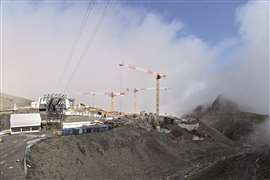 Tricky access to the mountain site meant some towers were assembled by helicopter. (Photo: Manitowoc)
Tricky access to the mountain site meant some towers were assembled by helicopter. (Photo: Manitowoc)
French construction company STGO partnered with Potain tower crane dealer Valente Grue Assistance (VGA) to update a cable car line in the ski resort of Les Deux Alpes.
The complex, high-altitude project featured a mix of Potain self-erecting and top-slewing tower cranes.
To build the highest cable car stations, the company used two MDT 389 L16 cranes on fixing angles with 60 metre jibs. The cranes need up to 16 tonnes of capacity to handle the gondolas as well as other components for the ski lift. Elsewhere, the cranes lifted 5.5 tonne concrete buckets out to 60 metres. Supporting the two MDT 389 cranes were an MDT 249 and Igo T 130 self-erecting crane.
For the 1,600 metre cable car station, STGO and VGA deployed an MDT 349 flat top crane with 60 metre jib and a 42 metre height under hook. There was also an MDT 249 top-slewing crane on fixing angles with 55 metres of jib and an HD 25 self erecting crane. At the resort entrance to Les Deux Alpes, a GTMR 386 self erecting crane was put in place, unloading and reloading trucks to supply building materials to the project.
Another contractor, MBTM, is constructing a fourth station on the project using an MDT 389 leased from VGA. This crane is configured with a 25 metre hook height and 50 metre jib.
Potain dealer Uperio also supplied an MDT 98 to install a pylon for the redeveloped cable car which sat on a slope inaccessible by road. The crane had to be erected by helicopter.
Wilbert cranes timber-hybrid build
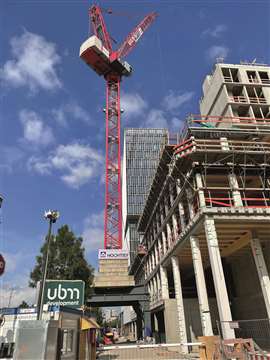 Wilbert says its crane is ideal for use in urban areas as it easily moves around buildings and other cranes. (Photo: Wilbert)
Wilbert says its crane is ideal for use in urban areas as it easily moves around buildings and other cranes. (Photo: Wilbert)
Two Wilbert cranes worked on the erection of a timber-hybrid building complex over a period of 12 months in Frankfurt, Germany. The PGE co-operation involved says that the timber-hybrid construction is 57 per cent lighter than conventional solid construction and is based on completely prefabricated modules.
Details of the crane operation concept were developed and implemented with the project’s general contractor Hochtief Infrastructure. The WT 405L e.tronic luffing jib crane with a capacity of 32 tonnes (capacity at the 50 metre jib tip is 7.2 tonnes) was erected on an 8 x 8 metre City Portal, as a solution had to be found for site access while ensuring a safe route for emergency services.
Although the tower height was relatively low at 44.8 metres, the crane achieved high working heights (minimum 55.7 and maximum 95.6 metres) thanks to the 50 metre luffing jib.
Wilbert says the crane is ideal for use in urban areas as it easily moves around buildings, neighbouring cranes or other obstacles and does not over slew any restricted areas.
The high lifting capacity of the WT 405L e.tronic luffing jib crane made it possible to lift the prefabricated modular timber-hybrid components into place. The powerful 140 kW high-rise winch additionally ensured fast working operations.
The second Wilbert crane, a WT 300 e.tronic flat top, was set up centrally in the middle of the two building sections so that it could serve the entire construction site with its 55 metre jib.
Wilbert says this crane’s capacity of 16 tonnes (5.7 tonnes at the tip of the 55 metre jib) is impressive. The structural framework of the building was completed in a record breaking time of just 15 weeks.
Eight Wolff cranes on mega construction
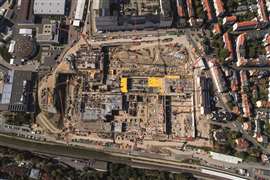 View from the top: Eight Wolffkran cranes build new site in Germany. (Photo: Wolffkran)
View from the top: Eight Wolffkran cranes build new site in Germany. (Photo: Wolffkran)
German construction company Riedel Bau is constructing a new high-tech site for Carl Zeiss in its hometown of Jena, Germany, using eight Wolffkran cranes.
Seven Wolff 7534.16 Clear cranes with tip loads of between 2.9 and 7.2 tonnes as well as a Wolff 6071.20 Cross with a tip load capacity of 9.6 tonnes are being used on the 80,000 square metre site.
Riedel Bau purchased two new flat top Wolff 7534.16 Clear cranes for the mega construction site.
The Wolff 6071.20 Cross, the only model with a tower top section, has a special role transporting several hundred precast concrete parts such as wall elements, columns, beams and floor slabs weighing up to 18 tonnes during its work.
In addition, there are plans for a total of six special lifts with individual weights of up to 22 tonnes.
Daniel Wandelt, a work planner at Riedel Bau, says, “One of the biggest challenges in this project is the founding of the cranes,” he explains. “In some cases, we have extended building foundations to form crane foundations. For example, we reinforced four foundations of a parking lot deck to use them as a base for an 8 x 8 metre cross frame element.”
“Because one of these integrated foundations must be dismantled again once the structural work has been completed, we also assembled empty conduits for a concrete saw when installing the foundation,” says Wandelt.
“The assembly of the cranes was a mammoth task in terms of planning and logistics. At one point there were over 25 trucks with crane parts on the construction site, as the first three cranes were assembled almost simultaneously. Everything has gone smoothly and according to the plan so far.”
The cranes are expected to lift reinforced concrete, masonry, and prefabricated parts into place by the end of 2024. The building shell should then be completed.
STAY CONNECTED


Receive the information you need when you need it through our world-leading magazines, newsletters and daily briefings.




